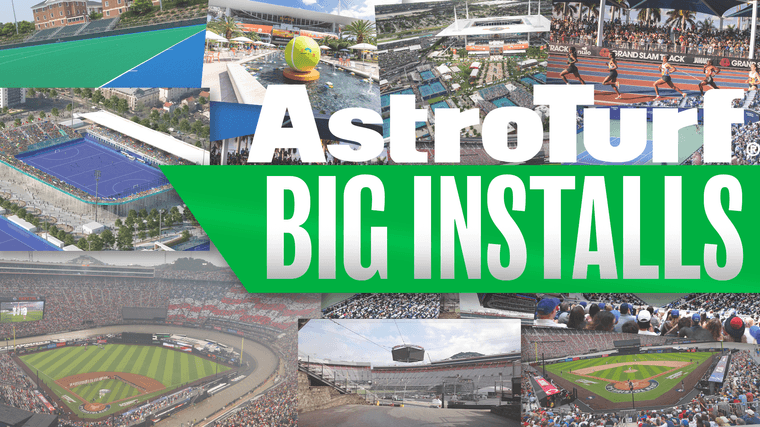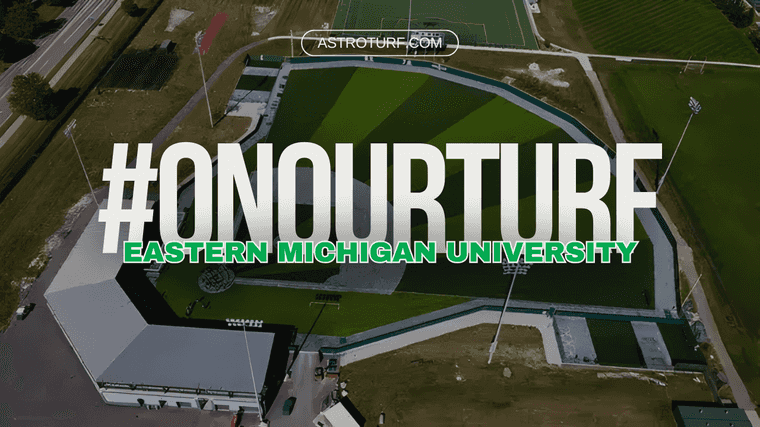AstroTurf’s Approach to Heat Management on Synthetic Turf Fields
It’s a well-known fact that synthetic turf fields can get hot, absorbing and retaining more heat than natural grass. While this can create higher temperatures at ground level, it’s essential to clarify that this is a player comfort issue rather than a safety concern. Research shows that while surface temperatures can rise, the heat dissipates as it moves upward, resulting in safer conditions at critical chest and head levels.
Research and Development: Addressing Heat Comfort
The Challenge: The synthetic turf industry is continuously working on innovative solutions to reduce heat on playing surfaces. Cooling the fields is vital to enhance player comfort during play. It’s a topic that companies have been discussing how to address and provide effective solutions to for many years.
Industry-Wide Solutions: Many turf companies have explored various methods to address this issue, often focusing on alternative infills. However, the reality is that no single solution can entirely eliminate heat buildup. As long as synthetic turf relies on plastic fibers, some degree of heat retention is inevitable. Moreover, many conventional cooling methods involve drawbacks, such as increased costs, potential environmental impacts, and excessive water usage.
AstroTurf’s Solutions: Innovation through Nature and Technology
AstroTurf’s R&D team has invested significant resources into developing practical solutions to manage heat on synthetic turf fields. While there isn’t a one size fits all solution, our approach combines both cutting-edge technology and natural materials to create a more comfortable playing environment for athletes.
SuperNatural Infill: One of our premier innovations is our SuperNatural infills, a line of organic based infills that provide cooling benefits in addition to being environmentally conscious. These infills absorb moisture from the environment—whether from rainfall, morning dew, or humidity—and slowly releases it as temperatures rise, naturally cooling the turf surface. The cooling process mimics how the human body uses perspiration to regulate temperature, providing a more consistent and effective cooling mechanism.
Aquifer Layer: Another breakthrough is our patented Aquifer layer, using a Zeolite mineral infill known for its impressive cooling properties. Zeolite’s unique honeycomb structure allows it to absorb and gradually release water, which can reduce field temperatures by up to 40 degrees Fahrenheit. This natural, water-efficient solution is sourced from the Southwestern United States and offers an affordable and low-maintenance option for keeping fields cooler without the need for frequent watering. When used in conjunction with a SuperNatural infill the cooling benefits can increase by a further 10 degrees.
Scientific Validation: Evidence from the University of Tennessee
Recent studies, including those conducted by the University of Tennessee, Knoxville, have validated the effectiveness of AstroTurf’s solutions. Research showed that surface temperatures on various synthetic turf systems were significantly higher than at elevated points, such as the ankle or knee (Williams 2022). However, the use of innovative infills like SuperNatural and ZChill can mitigate these temperatures, improving overall comfort without compromising performance.
Empirical Scientific Data Regarding AstroTurf and Heat
At the University of Tennessee, Knoxville, extensive research was conducted to assess the heat dynamics of various synthetic turf systems, including those developed by AstroTurf. The study involved testing multiple turf plots with different infills to measure the surface and radiant heat levels at various heights, simulating the conditions athletes experience during play (Williams 2022).
The findings confirmed that while surface temperatures on synthetic fields were notably higher than those of natural grass, the heat dissipated quickly as it rose from the ground. This key observation aligns with AstroTurf’s position that heat on turf fields is more of a comfort issue than a safety concern. By analyzing temperature differences at ankle, knee, hip, and shoulder heights, the study highlighted that the highest temperatures occurred at ground level, with a significant decrease as the distance from the surface increased. This validated the efficacy of cooling infills in reducing heat stress on players.
The study demonstrated that the most intense heat was confined to the area closest to the turf, with temperatures dropping by 24-36°F just a few inches above the surface. The rest of the airspace above the turf averaged about 2°F warmer than it was outside. This finding supports that heat retention on turf fields primarily affects player comfort rather than safety.
Sources Cited For This Breakdown
- Williams, Taylor. “UT AstroTurf Radiant Heat Report.” AstroTurf Research, University of Tennessee, 26 July 2022
- Project Play. (n.d.). Youth sports facts. Retrieved August 14, 2024, from https://projectplay.org/youth-sports/facts/benefits#:~:text=Physical%…
- Sherratt, P., & Munoz, M. (2017, April 25). Irrigating soccer fields prior to play. The Ohio State University, College of Food, Agricultural, and Environmental Sciences. Retrieved from https://u.osu.edu/athleticfieldmanagement/2017/04/25/irrigating-soccer-fields-prior-to-play/












